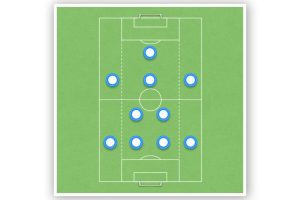The Importance of Set-Pieces in Soccer: A Comprehensive Guide
I have always been fascinated by the strategic use of set-pieces in the game. Set-pieces are a crucial aspect of soccer that can make or break a team’s chances of winning a match. A set-piece is a situation in which the ball is stationary and the game is restarted after a stoppage in play. These situations include free-kicks, corner-kicks, goal-kicks, throw-ins, and penalties.
Set-pieces are an excellent opportunity for teams to score goals or create goal-scoring opportunities. They allow teams to take advantage of the opposition’s weaknesses and exploit them. A well-executed set-piece can turn the game around and give a team the momentum it needs to win. However, the effectiveness of set-pieces depends on a team’s ability to plan and execute them correctly.
In this article, I will explore the use of set-pieces in soccer and how they can be used to gain an advantage over the opposition. I will examine the different types of set-pieces and their strategic importance in the game. Additionally, I will analyze the role of individual players in the execution of set-pieces and how they can contribute to a team’s success.
What are Set-Pieces?
Set-pieces are a crucial part of the game. A set-piece is a situation where play is restarted after a stoppage, such as a foul or the ball going out of bounds. These situations include corner kicks, free kicks, goal kicks, throw-ins, and penalties.
Set-pieces are an opportunity for teams to create chances and score goals. They can be a result of great teamwork, individual brilliance, or a mistake from the opponent. Teams often have specific set-piece plays that they practice and execute during games.
During a set-piece, both the attacking and defending teams have specific roles and responsibilities. The attacking team will try to create space and opportunities to score, while the defending team will try to prevent the attacking team from scoring.
Successful set-piece plays require coordination, communication, and skill. It’s essential for players to understand their roles and execute their tasks with precision. In the next section, I will discuss the different types of set-pieces and how they are used in the game.
Why are Set-Pieces Important in Soccer?
Set-pieces are a way to create scoring opportunities, break down defenses, and change the momentum of the game. In this section, I will discuss why set-pieces are so important in soccer.
Creating Scoring Opportunities
Set-pieces are a great way to create scoring opportunities. When a team is awarded a free-kick or a corner, it provides an excellent chance to put the ball into the box and create a goal-scoring opportunity. A well-executed set-piece can be the difference between winning and losing a game.
Teams often have players who specialize in set-pieces, and they work on specific routines and tactics during training. These routines can be incredibly effective, and a team can score a goal from a set-piece even if they are struggling to create chances during open play.
Breaking Down Defenses
Set-pieces can also be used to break down defenses. When a team is struggling to create chances during open play, a well-executed set-piece can be the perfect way to break down a stubborn defense. It can be challenging to break down a team that is sitting deep and defending in numbers, but a set-piece can provide a way to get in behind the defense and create a goal-scoring opportunity.
Changing the Momentum of the Game
Set-pieces can also change the momentum of the game. A team that is struggling to get into the game can be lifted by a well-executed set-piece. Conversely, a team that is dominating the game can be brought back down to earth by conceding a goal from a set-piece.
Overall, set-pieces are an essential part of soccer. They provide a way to create scoring opportunities, break down defenses, and change the momentum of the game. Teams that can execute set-pieces effectively will have a significant advantage over their opponents.
Types of Set-Pieces
Free Kicks
Free kicks are awarded to a team when an opposing player commits a foul. The location of the free kick is determined by where the foul occurred. There are two types of free kicks: direct and indirect. In a direct free kick, the player taking the kick may score a goal without the ball touching another player. In an indirect free kick, the ball must touch another player before a goal can be scored.
Free kicks can be taken quickly or after a delay, depending on the situation. Teams may use various tactics, such as faking the kick, to deceive the opposing team and create scoring opportunities.
Corner Kicks
Corner kicks are awarded to a team when the ball goes out of bounds over the opponent’s goal line without a goal being scored and was last touched by a defending player. The attacking team is awarded a corner kick, which is taken from the corner nearest to where the ball went out of bounds.
Corner kicks provide a great opportunity for teams to score a goal, as the ball is played directly into the penalty area. Teams may use various tactics, such as short corners or crossing the ball into the box, to create scoring opportunities.
Throw-Ins
Throw-ins are awarded to a team when the ball goes out of bounds over the touchline and was last touched by a player from the opposing team. The team that did not touch the ball last is awarded the throw-in, which is taken from the spot where the ball went out of bounds.
Throw-ins are typically used to advance the ball up the field and create scoring opportunities. Teams may use various tactics, such as long throws or short throws to a teammate, to create scoring opportunities.
Penalty Kicks
Penalty kicks are awarded to a team when a defending player commits a foul inside their own penalty area. The attacking team is awarded a penalty kick, which is taken from the penalty spot.
Penalty kicks provide a great opportunity for teams to score a goal, as the ball is placed just 12 yards away from the goal. Teams may use various tactics, such as faking the kick or placing the ball in a specific spot, to deceive the opposing goalkeeper and create scoring opportunities.
Set-Piece Strategies
As a coach, I believe that set-pieces are an essential part of soccer. They offer great opportunities to score goals or prevent them, and can be a game-changer in tight matches. In this section, I will discuss some offensive and defensive strategies that can be used to maximize the potential of set-pieces.
Offensive Strategies
When it comes to offensive set-pieces, the key is to create confusion in the opposing team’s defense. One effective strategy is to use decoy runners to draw defenders away from the intended target. This can be achieved by having one or two players make a run towards the ball, then quickly change direction and run towards the goal. This will create space for the intended target to receive the ball and take a shot on goal.
Another strategy is to use a “wall of players” to block the goalkeeper’s view. This can be achieved by having 2-3 players stand in front of the goalkeeper, forcing him/her to move to get a clear view of the ball. This can create an opportunity for a shot on goal or a cross into the box.
Finally, it’s important to vary the type of set-piece used. Teams should practice different types of free-kicks, corner kicks, and throw-ins to keep the opposing team guessing and prevent them from developing a pattern of play.
Defensive Strategies
Defensive set-pieces are all about organization and communication. The first step is to assign specific roles to each player, such as marking a specific player or zone. This will ensure that all players know their responsibilities and prevent confusion.
Another effective strategy is to use a zonal marking system. This involves dividing the penalty area into zones and assigning players to defend each zone. This can be effective as it allows defenders to cover more ground and reduces the risk of leaving players unmarked.
Finally, it’s important to practice defending set-pieces regularly. This will allow players to develop a good understanding of each other’s roles and improve communication on the field.
Training for Set-Pieces
Set-pieces are an essential part of soccer, and training for them is crucial for a team’s success. I prioritize set-piece training to ensure that my team is well-prepared for any situation that may arise in a game.
During training sessions, I focus on specific set-piece scenarios such as corner kicks, free kicks, and throw-ins. I also ensure that my players understand their roles and responsibilities during each set-piece scenario. This includes assigning specific players to take the set-piece, players to be in charge of creating space, players to be in charge of marking, and players to be in charge of attacking the ball.
One effective way to train for set-pieces is to use video analysis. I record and analyze our team’s set-piece performance during games and training sessions. This helps me identify areas that need improvement and allows me to provide feedback to individual players to help them improve their set-piece skills.
Another training technique is to use set-piece drills. These drills focus on specific set-piece scenarios and help players improve their technique and decision-making skills. For example, a corner kick drill could involve practicing different types of crosses, such as a near-post or far-post cross, and the players’ movements and positioning to receive the ball.
Finally, repetition is key to mastering set-pieces. I ensure that my team practices set-pieces regularly, so they become second nature to the players. This allows them to execute set-pieces with confidence and precision during games.
Conclusion
Throughout this article, I have explored the use of set-pieces in soccer and why they are important. Set-pieces, which result from a stoppage in play, give the offensive team an uncontested opportunity to pass or shoot the ball. They can come from a free kick, goalie kick, corner kick, penalty kick, and throw-in.
As we have seen, set-pieces can play a crucial role in the outcome of a soccer match. In fact, research has shown that set-pieces account for 30% to 40% of goals scored in elite soccer matches. This highlights the importance of set-piece strategies and the need for teams to have designated set-play coaches.
Effective set-piece strategies involve careful planning, execution, and teamwork. Coaches must analyze their opponents’ weaknesses and strengths and devise a set-piece plan that plays to their team’s strengths. This may involve practicing set-pieces extensively on the training ground, creating specific set-piece routines, and assigning specific roles to players.
Overall, the use of set-pieces in soccer is an essential aspect of the game that can make the difference between winning and losing. Teams that can effectively execute set-piece strategies have a significant advantage over their opponents. As a result, coaches and players must dedicate time and effort to perfecting their set-piece tactics.








